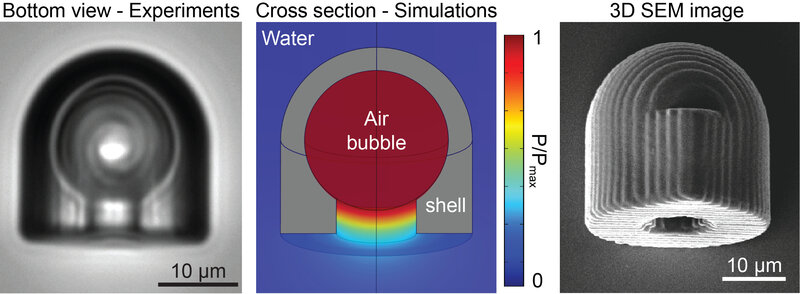
Researchers at the Max Planck Institute for Intelligent Systems in Stuttgart have designed and fabricated an untethered microrobot that can slip along either a flat or curved surface in a liquid when exposed to ultrasound waves. Its propulsion force is two to three orders of magnitude stronger than the propulsion force of natural microorganisms such as bacteria or algae. Additionally, it can transport cargo while swimming. The acoustically propelled robot hence has significant potential to revolutionize the future minimally invasive treatment of patients.
Stuttgart—Researchers at the Max Planck Institute for Intelligent Systems (MPI-IS) in Stuttgart developed a bullet-shaped, synthetic miniature robot with a diameter of 25 micrometers, which is acoustically propelled forward—a speeding bullet, in the truest sense of the word. Less than the diameter of a human hair in size, never before has such an actuated microrobot reached this speed. Its smart design is so efficient it even outperforms the swimming capabilities of natural microorganisms.
The scientists designed the 3-D-printed polymer microrobot with a spherical cavity and a small tube-like nozzle towards the bottom (see figure 1). Surrounded by liquid such as water, the cavity traps a spherical air bubble. Once the robot is exposed to acoustic waves of around 330 kHz, the air bubble pulsates, pushing the liquid inside the tube towards the back end of the microrobot. The liquid's movement then propels the bullet forward quite vigorously at up to 90 body lengths per second. That is a thrust force two to three orders of magnitude stronger than those of natural microorganisms such as algae or bacteria. Both are among the most efficient microswimmers in nature, optimized by evolution.
Deploying ultrasound waves to actuate microrobots is not a new approach. However, previous robots with swimming capabilities have shown to be relatively slow, difficult to control near surfaces, and have had a relatively short operating time of only a few minutes. All of these factors are obstacles to their use in medical applications for targeted drug delivery, detoxification, or noninvasive surgeries. The scientists of the Physical Intelligence Department at the MPI-IS, Dr. Amirreza Aghakhani, Oncay Yasa, Paul Wrede, and Dr. Metin Sitti, who is the department's Director, were able to fine-tune their robot's steering capabilities while increasing the operating time to several hours. Their publication "Acoustically powered surface-slipping mobile microrobots" was published in the Proceedings of the National Academy of Sciences in February 2020.

In addition to designing the robot with an inside cavity trapping a spherical air bubble with a small opening, they added a small fin to the microrobot's cylindrical body surface (see figure 2), which biases the propulsion direction. They also coated the top of the polymer bullet with a soft magnetic nanofilm layer. With the help of surrounding external magnetic fields, they were then able to alter the direction of the bullet left or right, as well as up or down.
In several experiments, the researchers tested how capable their robot is of moving on different surfaces inside a microchannel similar to a blood vessel. They exposed the robot to acoustic waves and a magnetic field and succeeded in navigating it in this confined 3-D space. They also showed that the trapping of cargo happens automatically while the microrobot moves. While the liquid is being pushed out of the robot's cavity when exposed to ultrasound waves, a circular microstreaming pattern is generated towards the bottom (see figure 2). This current ensures that surrounding drug particles are guided towards the robot. There, the particles are amassed and are transported away with the movement of the robot. Thanks to this, the robot could one day be applied to collect cancer drug particles inside the bloodstream and specifically transport the drug towards a carcinoma, releasing the cargo at a close range for maximum impact.
Dr. Amirreza Aghakhani, a postdoctoral researcher in the Physical Intelligence Department and the co-lead author of the publication, summarizes the special features of the microrobot: "We can actuate our microrobots very efficiently, and they are also very fast. Ultrasound is harmless to the body and can penetrate into regions deep inside the body. We can move these robots on both flat and curved surfaces in a controlled manner and we can attach different cargo, such as drugs. This is impressive."
Another benefit is ultrasound imaging. Inside the body, imaging is very challenging when the robot is only several micrometers in size. "However, the trapped air bubble can act as a contrast agent, making the robot and its location more visible," Dr. Aghakhani adds.
"Our vision is to deploy such acoustically powered and magnetically steered microrobots inside the human body for various noninvasive medical applications in the near future," Dr. Metin Sitti concludes.
More information: Amirreza Aghakhani et al. Acoustically powered surface-slipping mobile microrobots, Proceedings of the National Academy of Sciences (2020). DOI: 10.1073/pnas.1920099117
Citation: Acoustically driven microrobot outshines natural microswimmers (2020, February 4) retrieved 4 February 2020 from https://techxplore.com/news/2020-02-acoustically-driven-microrobot-outshines-natural.html
This document is subject to copyright. Apart from any fair dealing for the purpose of private study or research, no part may be reproduced without the written permission. The content is provided for information purposes only.
